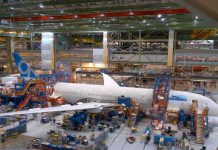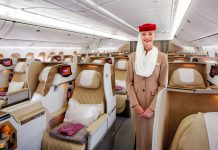Airbus has launched a total rethink of cabin interiors to save weight and ensure 100 per cent recyclable products.
Dubbed Airspace Cabin Vison 2035+ Airbus reached out to 10 airlines, including Air New Zealand, Delta Air Lines and Lufthansa, as well as eight technology suppliers, to evolve the futuristic cabins which it hopes to incorporate into its hydrogen-powered concept aircraft by the middle of the next decade.
Airbus also sought input from detailed passenger surveys to define the main guidelines of cabin product development.
Air New Zealand Airline of the Year 2023.
JOIN: AirlineRatings.com YouTube Channel
GET: Accurate MH370 Information From AirlineRatings.com Newsletter
It says the aircraft cabin contributes 10-20 per cent of the overall aircraft environmental impact, while in parallel, passenger research shows that 80 per cent of companies incorporate sustainable travel policies and that 40 per cent of travellers are willing to pay for CO2-neutral tickets.

The Airspace Cabin Vision 2035+ is all about reimagining the future travel experience by prioritising sustainability while maintaining superior levels of comfort.
Airbus says this can be achieved via a paradigm shift leveraging digital processes and tools, bionic structures and a circular design philosophy.
This first phase of the project is called “Transparency” and by 2025 Airbus says that it will provide full transparency on the environmental impact of cabin parts and operations.
It plans to offer CO2 emission cabin options and more efficient cabin operations to airlines while establishing a framework for cabin end-of-life management and first solutions.
Decarbonisation is the second phase and by 2030 Airbus says it will be introducing new cabin interior solutions and materials with low CO2 impact.
It plans to reduce significantly cabin products’ waste during production and landfill at end-of-use and establish new end-of-life management approaches
By 2035 Airbus will have introduced what it calls “Circularity” and integrate the next generation cabin in a hydrogen-powered aircraft and support the reduction of emissions intensity for the existing global aircraft fleet. It plans zero landfill and incineration of cabin materials at end-of-use, except if required by regulation.

Airbus plans the establishment of what it terms “a circular cabin” based on the elimination of waste and pollution as well as the circulation of products and materials.
Airbus says that it has a business class seat concept that gains 10 per cent more room while reducing weight saving by 30 per cent.
Some of the concepts include using waste hand washing water to flush toilets, passengers on long haul flights would pre-order their meals to cut wasteful duplication of meals, while short-haul passengers would simply pick up a snack box at the gate lounge.
The catering changes could reduce waste by 15 per cent says Airbus.
Airbus is working on three hydrogen concept aircraft that were first revealed in 2020.
All of these concepts rely on hydrogen as a primary power source – an option which Airbus believes holds exceptional promise as clean aviation fuel and is likely to be a solution for aerospace and many other industries to meet their climate-neutral targets.

The three concepts (above) – all codenamed “ZEROe” – for a first climate-neutral zero-emission commercial aircraft include:
A 120-220 seat turbofan design capable of operating trans-continentally and powered by a modified gas-turbine engine running on hydrogen, rather than jet fuel.
A 100-seat turboprop design using a turboprop engine and also powered by hydrogen combustion in modified gas-turbine engines, which would be capable of travelling up to 1600km.
A 200-seat “blended-wing body” (below) design in which the wings merge with the main body of the aircraft with a range similar to that of the turbofan concept. The exceptionally wide fuselage opens up multiple options for hydrogen storage and distribution and for cabin layout.

























